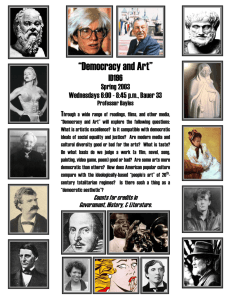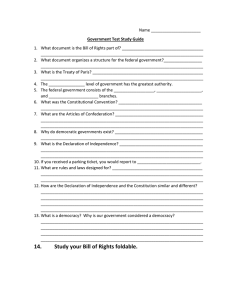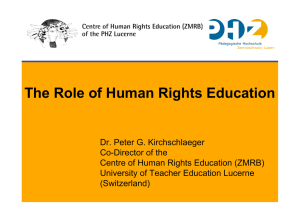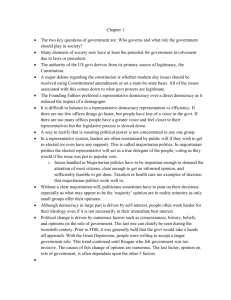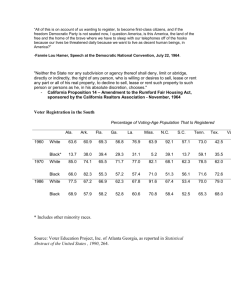As long as control of the individual resources of a... "Just as the regimen of the healthy is not suited...
advertisement
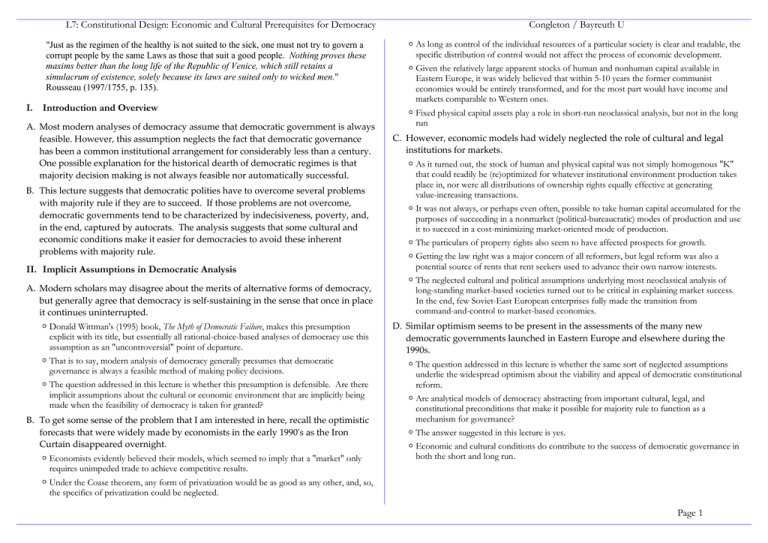
L7: Constitutional Design: Economic and Cultural Prerequisites for Democracy "Just as the regimen of the healthy is not suited to the sick, one must not try to govern a corrupt people by the same Laws as those that suit a good people. Nothing proves these maxims better than the long life of the Republic of Venice, which still retains a simulacrum of existence, solely because its laws are suited only to wicked men." Rousseau (1997/1755, p. 135). I. Introduction and Overview A. Most modern analyses of democracy assume that democratic government is always feasible. However, this assumption neglects the fact that democratic governance has been a common institutional arrangement for considerably less than a century. One possible explanation for the historical dearth of democratic regimes is that majority decision making is not always feasible nor automatically successful. B. This lecture suggests that democratic polities have to overcome several problems with majority rule if they are to succeed. If those problems are not overcome, democratic governments tend to be characterized by indecisiveness, poverty, and, in the end, captured by autocrats. The analysis suggests that some cultural and economic conditions make it easier for democracies to avoid these inherent problems with majority rule. II. Implicit Assumptions in Democratic Analysis A. Modern scholars may disagree about the merits of alternative forms of democracy, but generally agree that democracy is self-sustaining in the sense that once in place it continues uninterrupted. Donald Wittman's (1995) book, The Myth of Democratic Failure, makes this presumption explicit with its title, but essentially all rational-choice-based analyses of democracy use this assumption as an "uncontroversial" point of departure. That is to say, modern analysis of democracy generally presumes that democratic governance is always a feasible method of making policy decisions. The question addressed in this lecture is whether this presumption is defensible. Are there implicit assumptions about the cultural or economic environment that are implicitly being made when the feasibility of democracy is taken for granted? B. To get some sense of the problem that I am interested in here, recall the optimistic forecasts that were widely made by economists in the early 1990's as the Iron Curtain disappeared overnight. Economists evidently believed their models, which seemed to imply that a "market" only requires unimpeded trade to achieve competitive results. Under the Coase theorem, any form of privatization would be as good as any other, and, so, the specifics of privatization could be neglected. Congleton / Bayreuth U As long as control of the individual resources of a particular society is clear and tradable, the specific distribution of control would not affect the process of economic development. Given the relatively large apparent stocks of human and nonhuman capital available in Eastern Europe, it was widely believed that within 5-10 years the former communist economies would be entirely transformed, and for the most part would have income and markets comparable to Western ones. Fixed physical capital assets play a role in short-run neoclassical analysis, but not in the long run C. However, economic models had widely neglected the role of cultural and legal institutions for markets. As it turned out, the stock of human and physical capital was not simply homogenous "K" that could readily be (re)optimized for whatever institutional environment production takes place in, nor were all distributions of ownership rights equally effective at generating value-increasing transactions. It was not always, or perhaps even often, possible to take human capital accumulated for the purposes of succeeding in a nonmarket (political-bureaucratic) modes of production and use it to succeed in a cost-minimizing market-oriented mode of production. The particulars of property rights also seem to have affected prospects for growth. Getting the law right was a major concern of all reformers, but legal reform was also a potential source of rents that rent seekers used to advance their own narrow interests. The neglected cultural and political assumptions underlying most neoclassical analysis of long-standing market-based societies turned out to be critical in explaining market success. In the end, few Soviet-East European enterprises fully made the transition from command-and-control to market-based economies. D. Similar optimism seems to be present in the assessments of the many new democratic governments launched in Eastern Europe and elsewhere during the 1990s. The question addressed in this lecture is whether the same sort of neglected assumptions underlie the widespread optimism about the viability and appeal of democratic constitutional reform. Are analytical models of democracy abstracting from important cultural, legal, and constitutional preconditions that make it possible for majority rule to function as a mechanism for governance? The answer suggested in this lecture is yes. Economic and cultural conditions do contribute to the success of democratic governance in both the short and long run. Page 1 L7: Constitutional Design: Economic and Cultural Prerequisites for Democracy III. A. Indecisiveness and Majority Rule The first problem that has to be overcome by a democratic government is indecisiveness. A very large literature suggests that majority rule will not be able to consistently rank policy alternatives, nor make policy decisions that are stable through time. In unconstrained collective choice settings, every policy can be beaten by another, Arrow (1963). Theory, thus, suggests that unconstrained democracy will be unable to make policy decisions. B. To illustrate this fundamental problem, consider a medieval city whose citizens have agreed to build a defensive wall around their city. Suppose that all relevant parties within the city (voters) have agreed on the design of the wall and its placement, and now confront the problem of paying for it.1 Suppose, further that there are three equal-sized groups of persons entitled to participate in the majoritarian decision making process used by the community: shepherds, masons, and merchants. C. A broad range of methods for financing the wall can be proposed by those participating in the decision. i. The first proposal for financing the wall might require all citizens to make equal contributions toward building the wall. Such an apportionment may be plausibly justified from the public-good nature of the wall. The benefits of the wall are more or less uniformly distributed within the city. The distribution of the tax burden can be written as (Tshepherd, Tmason, Tmerchant) which in this case is (4, 4, 4). ii. A second proposal for funding the wall's construction might be based on comparative advantage. Perhaps, the wall should be provided by those best able to provide the needed services, which in this case would be those already skilled at wall construction. Some might argue that "clearly" the middle class masons should be public spirited and construct the wall for the city, ( 2, 8, 2). iii. Another proposal might be developed based on differences in the ability of the townspeople to pay for the public services. Proponents of that view might reason that the community should take account of physical or wealth differences among citizens. After all, some persons can more readily shoulder the burden than others ( 1, 5, 6). Congleton / Bayreuth U iv. A fourth proposal might attempt to account for the fact that poor persons could benefit from learning the craft of masonry, and, moreover, have more free time available for undertaking the required work. The shepherds have the most to gain, or the least to lose by undertaking most of the work. Indeed, it could be claimed that the others groups were already busy carrying the burden of expanding the town's cathedral ( 6, 4, 2). v. Since all four tax systems are sufficient to finance the public good of interest here, any will serve, but none-the-less, a decision has to be made. Consider that choice under majority rule. As rational voters, it is natural to assume that the members of each group will favor the tax regime that minimizes their tax burden. However, if votes are based only on anticipated tax burdens and the range of tax instruments is unconstrained, there may not be a stable majoritarian equilibrium. There is, for example, a majoritarian cycle among the first three proposals. In each case, two of the three groups benefit from lower taxes as the distribution of tax schedule used to fund the wall changes. Consequently, the second proposal can defeat the first, the third the second, and the first the third. As long as the previously defeated proposals can be reintroduced, majority rule will never reach a final decision, and the wall remains unfinanced and unbuilt. vi. Our democratic city seems likely to disappear as the next roving military force conquers it, or expansionary neighbor annexes it, while the town deliberates. Arrow (1963) points out that this problem is surprisingly general and extends to other collective decision making rules as well as to majority rule. D. Institutionally-Induced Stability i. The fact that the possibility of majoritarian cycling has only recently been puzzled out by political theorists suggests that such problems have not often been observed. There are at least three possible explanations for this. ii. First, majoritarian cycles may be so critical for democracy that decision failures of this sort lead democracies to be rapidly replaced by other forms of government. If true, this explanation would explain the dearth of democratic regimes in recorded history. Perhaps, only a few democratic regimes have managed to avoid the cycling problem. An obvious solution to majority indecision would be to let a prominent leader make the policy decisions for community of interest. iii. Second, majoritarian procedures might be modified or constrained in a manner that allows decisions to be reached. It bears noting that in this circumstance essentially any financial method sufficient to assure the wall's construction would be Pareto efficient. (That is, the result satisfies the familiar Samualsonian (1954) conditions for production of a pure public good.) 1 Page 2 L7: Constitutional Design: Economic and Cultural Prerequisites for Democracy An ongoing cycling problem would be obvious to the participants of any democratic forum, and, once recognized, most participants would agree to adopt procedures that avoid cycles. Shepsle and Weingast (1991), and Bernholz (1986) have shown that restrictions on the order and range of alternatives can assure stable majoritarian outcomes in a broad range of issue spaces. Majoritarian decisiveness can be assured in our medieval town if a procedural rule is adopted that limits financing options to whole numbers, and rules out reconsideration of defeated proposals. Such procedural and domain constraints would assure an eventual decision, although the tax structure selected would be affected by the order in which proposals are considered.2 Alternatively, majoritarian decisiveness can also be assured if an agenda setter is selected, although the outcomes may not look very democratic. iv. However, institutional solutions may be difficult to work out because the same cycling problems that are present in the funding of public good projects also tend to be associated with majority decisions over procedural rules and constraints for avoiding the cycling problem. E. Culturally Induced Stability i. A third possibility is that voter preferences or policy agendas may be such that the conditions for cyclic majorities rarely occur. Widely held norms may generate broad agreement about the "proper" way to fund public works or to organize the agenda of town meetings. For example, Buchanan and Congleton (1998) demonstrate that the use of a generality norm--the norm that all citizens be treated equally by government--tends to increase the efficiency of governance, in part by avoiding cycling problems. In the wall illustration, agreement to equally divide the burden of the collective enterprise implies a single unique distribution of tax burden (4, 4, 4), and the wall gets built. Similar results also hold for the other normative theories in the example as well. If only one of them is widely supported, three of the tax schemes would be widely regarded to be unacceptable because they yield burdens that are "improper" or "unfair." Insofar as the wall is a true public good, there is no conflict in this case between the use of widely accepted norms as a guide for policy development and narrow self interest. ii. In case where norms do not lead directly to particular policy outcomes, norms may limit the domain of policy alternatives in a manner that helps assure stability. For example, a consensus that taxes should be based on ability to pay tends to limit tax systems to a relatively small subset of those which can fund the desired public goods, although it does not imply a unique distribution of tax burdens. Congleton / Bayreuth U Cycles may also be curtailed by procedural norms. For example, it may be widely regarded as improper or unsportsmanlike to reintroduce tax schemes that have already been defeated. Ideally, stability enhancing norms reduce the range of potentially acceptable policies to ones with a single peaked distribution of voter preferences, and limit acceptable procedures to ones that curtail cycling in cases where cycling would otherwise occur. iii. It bears noting that in order for norms to bind, normative theories have be widely internalized by many individuals or broadly supported within the community of interest. That is to say, norms themselves have to influence day-to-day decision making as well as political deliberations, although such norms do not have to constrain everyone in the community. In the wall example, the normative arguments used by proponents of particular assignments of the cost of the wall might have been self-serving in the sense that each proponent appealed to the normative theory that minimizes their tax burden. However, clearly, there is no reason to employ norm-based rhetoric unless normative arguments are convincing in a manner not directly tied to personal wealth or income. The widespread use of normative rhetoric by policy proponents suggests that some widely held norms do not always encourage wealth maximizing behavior. Otherwise, norm-based arguments would be no more effective than arguments based on wealth. If only wealth or income matters when selecting norms, then only arguments based on wealth can be persuasive. IV. Avoiding the Redistributive Poverty Trap A. Once institutions or culture allow policy decisions be made, the next problem confronted by a democratic polity is making the "right" policy decisions, namely those which advance the shared interests of community members. i. There is no guarantee that such policies will be forthcoming from majority rule decision making. ii. After all, the pivotal member of the majority coalition is not normally the smartest, best informed, or most experienced person in his community. For example, the median voter's policy analysis will naturally reflect his or her limitations. Although, the Condorcet's jury theorem suggests that the democratic policy choices tend to be better informed than the median's capabilities immediately suggest. iii. Moreover, if relatively few policy mistakes are made, the median voter's policy interests may not be those which lead to prosperous societies. One policy area in which median voter interests can easily lead to disaster is redistribution. In addition to constraints on the order or range of issues that may be voted on, groups could rely upon other voting rules that are less cycle prone. However for the purposes of this lecture, a majoritarian focus seems most appropriate. 2 Page 3 L7: Constitutional Design: Economic and Cultural Prerequisites for Democracy V. The Meltzer-Richard Model And the Majoritarian Poverty Trap A. A very influential lecture by Meltzer and Richard (MR, 1981) characterizes incentives for a decisive democracy to redistribute income. B. The MR model assures decisiveness by restricting the domain of permissible tax and transfer mechanisms. i. All tax revenues are generated by a proportional tax on income, and the tax revenue generated is entirely used to fund a demogrant program. ii. Each voter pays the same flat-tax rate on his or her income, and each receives the same lump sum transfer payment. iii. The restricted domain of fiscal policy together with the assumption that voters behave as income or wealth maximizers imply that the policy choice is effectively single dimensional, and consequently, majority rule tends to yield the redistributive program preferred by the median voter. C. MS demonstrates that the policy preferences of a wealth-maximizing median voter depend upon the magnitude his or her income level relative to the average income in the community of interest. i. If the median voter has above average income, he or she will prefer no redistribution. In that case, the median voter always pays more in tax than is received from the demogrant program. ii. If the median voter has below average income, he or she may prefer substantial redistribution. In that case, the demogrant exceeds the tax paid by the median voter. In the case emphasized in MR's work, the tax rates will be set so that marginal increases in the demogrant equal the marginal reduction in personal income generated by the tax's deadweight loss. Conditions for such an equilibrium is depicted in figure 1. (People are presumed to work and save less as the tax rate is increased.) iii. For median voters with nearly average income levels, optimal redistribution will be fairly moderate. This is the case stressed in MR's work, and in most of the subsequent research built upon the MR foundation. D. There is, however, another possibility associated with settings in which the median income is below average income. i. In cases where the median voter's income is well below average, the median voter's preferred level of redistribution may be very large. ii. In the limit, the tax rate could be set at 100% and all of the polity's wealth would be redistributed via the demogrant program. Congleton / Bayreuth U In this case the majoritarian state would be all embracing, and financial incentives to work and save beyond that required for personal subsistence would disappear. Any person who earned above average income will have their above average income taxed away. (Illustrate the geometry of this case.) E. Economic Escape From the Majoritarian Poverty Trap: A Broad Middle Class i. The Meltzer and Richard model, besides indirectly pointing to a potential failing of majority decision making in societies with substantial income inequality, provides a possible solution for that problem. An implication of their analysis is that democracy will avoid the poverty trap whenever economic development reaches a stage where there is a large middle class--e.g. where median income is sufficiently close to average income that radical redistribution is not undertaken. In such cases, material welfare will not be directly undermined by majoritarian policy decisions because the gains to the median voter from such policies are more than offset by the combination of their own tax costs and reductions in the aggregate tax base. ii. From this perspective, democracy may have been more viable in the United States than in Europe in 1800 because the US had an advantageous distribution of income. Although there were many wealthy men in America, as evidenced by the founding fathers, the open frontier allowed the bulk of Americans to have sufficient holdings of fertile land to maintain a comfortable "middle class" existence as independent farmers or shop keepers. There were no famines in America. iii. Democracy may have worked in 19th century America because economic conditions were sufficient to avoid the majoritarian poverty trap by providing the "right" median voter. iv. This economic-based majoritarian logic also provides a possible "political efficiency" defense of the wealth requirements for suffrage that were used throughout democratic Europe during the 19th century. Such requirements generated a median voter whose income exceeded the average of an electorate composed of all adults citizens. Perhaps Europe had to await sufficient industrialization to produce a median voter who would be less disposed to redistribution before universal suffrage could be adopted. There can be economic prerequisites for democracy. F. Constitutional and Cultural Escapes from the Majoritarian Poverty Trap i. In addition to favorable economic conditions, there are also constitutional and cultural solutions to the redistributive poverty trap. ii. For example, a polity's constitutional law may require the government to compensate owners for any resources taken over for public purposes. Page 4 L7: Constitutional Design: Economic and Cultural Prerequisites for Democracy Since, a good deal of wealth consists of tangible assets, such a constraint implicitly removes a good deal of the potential tax base from the tax roles. Income tax rates, budget size, and state borrowing can also be constrained procedurally or limited constitutionally.3 Alternatively, as noted above, the electorate could be limited to those with the least propensities for redistribution. iii. The problem with such constitutional restrictions is that it is difficult to motivate their adoption via broad majoritarian procedures. That is to say, a majority of the adult electorate would normally oppose such limitations in the circumstances of interest here, because those restrictions would reduce the present discounted value of transfers received by the median voter. The troublesome policies of interest here are actually in the interest of a majority of current voters. G. Fortunately, broadly held norms can also reduce the desired scope and the undesired effects of redistribution. i. Any internal norm that raises the marginal cost of redistribution tends to reduce the level of redistribution that will be favored by the median voter. ii. Consider the case in which the median voter has internalized a norm that calls for some idealized program of social insurance/demogrant program, perhaps subsistence demogrants. Such a norm implies that taxes below that required to fund the ideal would be more desirable than that based on narrow self interest alone and taxes above that ideal would be less desirable. The result illustrated avoids the poverty trap. Taxes and redistribution are higher than justified by the norms because economic interests in redistribution remain, but not impoverishing. (Illustrates the effect of such a norm on the Meltzer and Richard's demogrant program.) iii. Of course, norms do not have to be directly concerned with optimal redistribution to solve the redistributive problem. Any norm that inhibits "taking" from current owners whether for public or private purposes tends to reduce redistribution in a manner that makes the redistributive poverty trap less likely. For example, the modern Western characterization of ownership is often regarded as a legitimate and important personal right. Taking property from legitimate owners violates that norm regardless of the purpose advanced. Rules regarding what Richard Epstein (1985) calls "takings" are not always part of written constitutional documents, but are generally part of the public law in successful polities. iv. Ideology and political philosophy may also constrain economic self interest. 3 Congleton / Bayreuth U For example, if a minimal level of prosperity is a prerequisite for the democracy in question to be viable, those interested in democratic governance would accept constitutional rules that imply lower tax rates and accept smaller demogrants rather than risk its demise. In this manner, a widespread preference for democratic over other forms of government may be sufficient to defend a government against policies that would be in the interest of particular voters, but undermine support for democracy. Utilitarian norms and various forms of altruism also have this property over a significant range of transfers insofar as the interests of future citizens are taken account of. liberal norms also discourage large scale redistribution insofar as they oppose the development of a more intrusive state. (It bears noting that such theories were widely in use during the 19th century when democracy began to be more widely used to decide national policies throughout Europe.) v. Of course, it is also clear that broadly held norms can also reduce prospects for democratic success. A community with strong egalitarian norms will redistribute more than required to advance the material interests of the median voter. Similarly, a community that encourages envy and jealousy would also be inclined to redistribute more than an electorate motivated by narrow self interest. Philosophical and ideological views that undermine the legitimacy of the current pattern of ownership, similarly tend to reduce inhibitions about such redistributive policies. By making redistributive policies more desirable or less costly, such theories and norms clearly make the majoritarian poverty trap more likely to arise for a given distribution of income. VI. Can Winner Take All Elections Be Avoided? A. Suppose that a democratic polity has successfully overcome the problem of decisiveness and also successfully avoided the poverty trap through some combination of institutional and cultural devices. i. At this point, the resulting democratic society may be regarded as successful in that policy decisions are routinely made, and the policies adopted, if not perfect, at least avoid disaster. The economy thrives and citizens lead pleasant lives. ii. We now turn to problems that can arise when democracy is sufficiently successful that those in power have an interest in holding on to power. B. Once the political process is decisive and policies have generated a moderately prosperous and pleasant society, holding political power becomes a valuable asset. i. A stable majority coalition with control over policy making will naturally wish to retain that control in order to put in place policies which it favors and protect those already in place, whether constrained by a generality rule or not. See Buchanan and Brennan (1980) for an analysis of constitutional rules and tax regimes that would limit state revenues to levels far below national income. Page 5 L7: Constitutional Design: Economic and Cultural Prerequisites for Democracy ii. The power, prestige and wealth associated with holding governmental office, give elective representatives a clear interest in remaining in power ad infinitum. C. That is to say, neither the majority coalition nor its elected representatives have a direct interest in subjecting themselves to the next round of electoral competition if there is any chance that they might lose control over policy making. i. This problem clearly differs from the previous ones. ii. Cycling can undermine support for democratic institutions insofar as policy decisions are in a constant state of flux, government services are poor or nonexistent, and laws are only temporary measures that are weakly enforced. iii. The redistributive poverty trap implies that a policy choice is made, but that tax rates may be at such high levels that economic development is discouraged. Excessive redistribution may also clearly undermine support for democracy insofar as it leads to widespread poverty. Both these problems imply that democracy may not work very well or lead to attractive societies. Yet these problems only indirectly threaten the majoritarian decision making process itself by reducing public support for democracy and making a polity less resistant to conquest. iv. The possibility of majoritarian takeovers explored in this section implies that democracies may not be sustainable, even if they are decisive and prosperous, because majoritarian governments may adopt policies that undermine the ongoing electoral process that makes a polity democratic. D. Avoiding Majoritarian Takeovers -- Binding Electoral Winners i. Once a representative government is elected to office, the powers of the state become concentrated in the hands of a relatively small number of persons until the next election. If holding elective office is desirable for whatever reason, it is clear that elected representatives will use their policy making power to increase their own prospects for retaining office. ii. This desire to remain in office is, of course, an essential feature of a well-functioning representative democracy, and is one of the reasons why a properly constrained representative government may be expected to advance the interests of a majority of the electorate through time. Providing good service is one method by which members of the current government may increase their chances for reelection. iii. However, without constitutional or other constraints, a party's desire for continuation in office can also be advanced by indefinitely postponing the next election, or by passing laws that restrict or eliminate the ability of opposition parties to organize and solicit votes. Congleton / Bayreuth U appear to be an easier and road to reelection than adopting policies that please the next election's median voter. iv. In this sense, representative democracies are potentially more frail than direct democracies because a relatively small subset of the citizenry comes to have control over the procedures and constraints of governance and may not wish to give up that control. Such anti-majoritarian behavior by incumbents is difficult to rule out constitutionally, because it is unlikely that a written constitution will be rigorously enforced by the same persons that it is designed to constrain, particularly in cases where the government has a monopoly on force. In order to avoid majoritarian take overs, those elected to rule must have, or be given, a broader interest in both prosperity and majoritarian procedures than can be assured by their efforts to win a single election. E. How to Guarantee Constitutional Guarantees? i. A constitution can attempt to address the problem of elective takeover by dividing policy making power between a number of branches of government with the power sufficiently decentralized that no single branch has decisive policy making ability or legitimacy. ii. Gordon (1999) argues that the long lasting republics of Athens, Rome, Venice, the Netherlands and the United States all use this organizational device with great success. iii. In such cases, a single election does not create an entirely "new" government because the other branches are chosen in a manner that is more or less independent of a particular electoral outcome. For example, terms of office may differ and be staggered, or different electoral procedures may be used to select members of different branches of government. Moreover, one of the weaker branches of government can assigned special responsibility to monitor the constitutionality of the rest of the government. iv. Critics of divided governments often complain that divided governments are not fully democratic in that policy decisions are not immediately determined by the current electoral majority. However, in cases where the elections and electoral pressures effectively determine the membership of all branches of government over the course of several elections, such governments are majoritarian in the long run. That is to say, a durable majority can eventually determine all government agents and essentially all of its policies. There is no necessarily tension between democratic rule and divided government. F. Cultural Support for Electoral Competition i. Culture can also play a role in assuring that majoritarian procedures remain in place. Again, democratic ideology may play a role. In the absence of other constraints, changing the electoral rules and the circumstances of electoral competition to advance the incumbent government's own interests must often Page 6 L7: Constitutional Design: Economic and Cultural Prerequisites for Democracy ii. There may be a widespread regard for democratic arrangements that make it impossible for legislators to pass laws that significantly restrict electoral competition or postpone elections. Such supporting political cultures were present in all of the cases explored by Gordon (1999) who notes many cases in which a republic's electoral procedures were defended by its citizens at great personal risk. iii. However, democratic ideology is not a prerequisite for the viability of democratic polities. Even without a direct preference for particular forms of governance, other norms may make anti-majoritarian electoral procedures difficult to put in place. For example, norms of fair play and equal opportunity make laws favoring one candidate or party over another unacceptable, or at least less likely to be successful. A strong norm of promise keeping tends to inhibit elected officials from violating oaths of office and promises made to their electoral supporters. Norms favoring open and unrestricted debate tends to reduce the scope for one-sided policy pronouncements by dominant parties and encourage organized opposition. iv. Widely held norms can make the mere consideration of laws that undermine electoral competition a very risky strategy at the level of both individual legislators and political parties. Not only would violating such norms be directly costly insofar as those norms are internalized by individual legislatures, but any legislator who violated or planned to violate such widely held norms would risk losing the next election.4 By ruling out a wide range of anti-majoritarian policies, such norms clearly reduce prospects for takeovers by unfaithful agents of the median voter or majority coalition. G. Reducing Electoral Opposition to the Next Election i. Unfortunately, unfaithful office holders are not the only electoral threat to democratic procedures. ii. A substantial block of voters is also always made worse off by the prospect of the next election, namely those supporting the current government. iii. Consequently, self-interested electoral support for policies that bias elections in favor of the incumbent government always tend to exist, and even a suitably constrained government that is always a faithful agent of the electorate may adopt policies that limit competition in future elections. No self-interested member of a stable coalition that finds itself in power has a direct interest in being replaced in the next election. These self-interested antidemocratic electoral pressures can be reinforced or resisted by constitutional arrangements and cultural norms. Congleton / Bayreuth U iv. A polity's existing political institutions, cultural norms and prosperity all play a role in generating a consensus favoring majoritarian politics. For example, constitutional measures can reduce the advantages associated with control of government and reduce the risk of future losses from election turnovers. Equal protection laws, a takings clause, and generality norms for new laws and public programs limit the ability of the current majority to transfer the minority's wealth to the majority. Such constitutional provisions reduce the current majority's interest in holding on to power. Others reduce the ability of current majority to hold onto power once in office. Constitutional provisions that support open policy debate, a free press, free assembly, openness in the deliberation of governments, together with a general interest in politics as a source of entertainment, tend to assure a wide range of forums for policy debate. v. Still other norms shape the perceived self- interest of the political community. Cultural norms may increase directly support democracy by enshrining majoritarian procedures. The normative mainstream might be sufficiently democratic that antidemocratic majorities never arise, and adherence to constitutional procedures safely taken for granted. (In the United States, the importance of following "the constitution" is widely taught in schools, and widely accepted.) Broad cultural support for constitutional procedures and restrictions clearly reduces the likelihood that a majority favoring the end of democratic governance will emerge. vi. The electorate does not, of course, have to have a "taste" for electoral competition and majoritarian voting procedures in order to prefer democracy to dictatorship---but the overall value of majoritarian rule does have to be clear enough that a majority of voters prefer it to other alternatives. In order for democracy to remain viable, a majority of the electorate has to regard majority decisionmaking to be sufficiently attractive that no majority will attempt to end democratic rule through legislation. The existence of widely accepted "democratic" norms provides candidates with a clear incentive to espouse policies that are consistent with those normative theories and to establish a reputation that makes such rhetoric and commitments credible. H. On the other hand, not all widely held normative theories encourage democratic procedures. i. It bears noting that majoritarian problems can arise from both "anti" and "pro" majoritarian cultural trends. In Madison's words: "The aim of every political constitution is, or ought to be, first to obtain for rulers men who possess most wisdom to discern, and most virtue to pursue, the common good of society; and in the next place to take the most effectual precautions for keeping them virtuous whilst they continue to hold their public trust." Federalist Lecture 57, pg. 1. Madison evidently believed that the virtue of office holders is partly exogenous--an aspect of culture or personality--and partly endogenous--generated by the institutional environment in which elected rule makers find themselves. 4 Page 7 L7: Constitutional Design: Economic and Cultural Prerequisites for Democracy ii. Elitists and paternalists may favor laws that discourage open debate, which limit political news coverage and punish "unconventional" political views. iii. Alternatively, majoritarians may lobby for constitutions that grant every temporary majority complete control over government policy, including the constitution. If the former policy advocates are successful, constitutions may be amended to limit electoral competition. By undermining constitutional support for majoritarian procedures, such reforms clearly increases the importance of cultural support and self restraint--especially within political elites--for the continuation of democratic polities. If the latter are successful, "impediments" to the "popular will" may be eliminated and a system of governance put in place that unshackles every transient majority. iv. The risk anti-majoritarians will take control of majoritarian governments clearly increases with antidemocratic ideological tides and with democratic failures. (The first two sections of the lecture suggest that democratic governance can generate such results.) In the absence of a solid track record, history suggests that a majority will opt for a form of government that abandons democratic procedures. VII. Conclusion: How Difficult is Democratic Governance? A. The public choice literature suggests that majority rule is not a very robust form of collective decision making. i. It is prone to cycles. Congleton / Bayreuth U Moreover, a good constitution affects both economic conditions and political culture. Culture is not entirely exogenous. By making some patterns of behavior more attractive than others, and by promoting prosperity, constitutions indirectly affects the evolution of norms. C. However, the extent to which a very good constitution can assure good governance in the absence of a supporting culture is an empirical question. i. Many of the constitutions that failed in Africa during the 1960s or which have proven problematic in South America for much of the last century are based on constitutional models that have worked very well elsewhere. ii. The analysis of this lecture suggests that a polity that lacks favorable social circumstances will need far better institutions to achieve effective democratic governance than one that has fortuitous cultural and economic endowments. iii. The significance of culture in the performance of democratic governance does not mean that constitutional design is irrelevant, nor that culture is decisive. Rather it implies that the constitutional design problem facing a given polity is partly determined by the broadly held values and the economic circumstances of that polity. Culturally transmitted norms can help a society get effective constitutional rules in place, and once adopted there, reinforce them by providing unwritten rules that circumscribe policy making and reduce the effects of unavoidable policy errors. It seems likely that successful democracies have developed a combination of political and legal institutions that is grounded and enhanced by widely shared norms within the community of interest that jointly serve as a springboard for escaping the fundamental binds of majoritarian decision making. ii. It may yield very high tax rates. iii. Moreover, incumbents may use the power of the state to secure permanent advantages from even short periods of office. Indeed, a majority may not even favor holding the next election. If these problems are as difficult to solve as the literature seems to suggest, they provide a plausible explanation for the dearth of democratic regimes through most of recorded history. B. Many of those problems, once recognized, can be addressed by well-conceived constitutions that advance the long-run interests of narrowly self-interested individuals as has been emphasized by analysts working within the constitutional political economy tradition. Constitutions may usefully address such matters as election law, freedom in political debate, access to information and freedom to run for office and organized politically interested groups. Additional support for democratic procedures can be provided by specifying an appropriate division of power and by specifying formal constraints that attempt to broadly align the interests of elected rulers with those of the constitution and the electorate. Page 8
